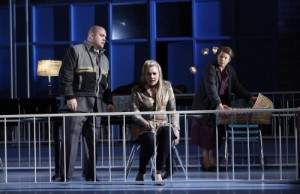Janice L. Mayer
Over the weekend I visited my elderly uncle in his nursing home in Massachusetts. It’s a pleasant place – as these facilities go – in Duxbury. Uncle Dick is Red Sox baseball fanatic who was recruited by the minor league in his day. I purchase a Baseball Hall of Fame Inductee T-shirt for him every year when I visit Glimmerglass Opera in Cooperstown and the presentation of the shirt with the new autographs, along with a review of ‘the greats,’ has become a family tradition. Uncle Dick has advanced Alzheimer’s disease now and his days of reciting the scores of legendary ballgames is behind him. He often asks, “What happened?” That question can baffle a visitor. Does it refer to the wide-ranging question of how did he land in this predicament, or more simply what happened to breakfast? Either is possible.
Artists historically have challenged us to make sense of ‘what happened?’ Think of folk singer Pete Seeger, now celebrating his 90th year, challenging us all to deal with ‘what happened’ to the Hudson River and how to revitalize the environment in his folk songs aboard the The Clearwater. Think of Joan Baez reacting to ‘what happened’ in Vietnam and fueling the peace movement of the 1960s with Cambodia and her other heartfelt anti-war songs. And who can forget the late, soulful singer Odetta whose rendition of I’m On My Way moved the crowd to action at the 1963 Civil Rights March on Washington? We know ‘what happened’ in our Nation’s capital, and across the South, as a result. Recently I saw two productions whose creators were trying to make sense of ‘what happened’ in Louisiana in the aftermath of Hurricane Katrina.
Jacob’s Pillow in Becket, Massachusetts is sacred ground to dancers in the modern dance tradition. Male modern dance originated there under choreographer Ted Shawn, and Ruth St. Denis, Agnes DeMille, Martha Graham, Twyla Tharp and almost any important female modern dancer one can think of had her creative spirit nurtured on the rambling grounds of what was originally a farm in the 1700s. Interestingly, Jacob’s Pillow was recently designated a historical landmark for its life-saving role as a sanctuary for the Underground Railroad. David Roussève and his diverse dance company, Reality, explored the effect of Katrina in his moving multi-dimensional, evening-length work Saudade. Violent movement subjugating the slighter more fragile dancers alternated with strapping company members heroically lifting up their partners in other sections of the piece. Movement was interspersed with spoken dialogue recited by the triple threat choreographer/ writer/performer, Mr. Roussève. A native son of Louisiana, he connected the dots beginning with the slave movement from Africa to the degradation of the inhabitants of 9th Ward in New Orleans post-Katrina – literally punctuating his progression with markers at each stopping point. This was not a linear story; rather one with advances and retreats in which he personified the see-saw of progress as he haltingly traveled a diagonal path across the stage. There was no clear, straight path to understanding here. Was it tough to watch? At some points, yes. Was the verbal and movement language rough? Yes, in that it reflected the brutality he was exposing. Clearly a gifted artist who is close to the subject, Roussève was grappling with major issues and might have been served by a second eye on the project. But then again, with the world’s eye on Katrina, the country sat bewildered and dazed in the aftermath of the storm. Should, we expect more of Roussève?
At Glimmerglass Opera in Cooperstown, I attended the dress rehearsal and opening performance of Gian Carlo Menotti’s The Consul. It is a story teaming with despair as dejected characters face bureaucraticinsensitivity as they plead for asylum. American director Sam Helfrich chose to set the action in Louisiana post-Katrina. While the set was non-site-specific in its industrial tone, Sam envisioned the movement of the characters into the consulate as like the relocation of the Katrina survivors into the Astrodome. By Act II they were carrying their personal effects – here symbolized by unlit lamps – and literally moving into the consulate. With little hope of escaping their miserable circumstances, the lights symbolically never illuminated their path to freedom.
It was interesting to me that in 2009 we have two creators working in different mediums trying to make sense of ‘what happened’ in 2005. Do we need to reflect on the actions, or perhaps inaction at that time? I would suggest that we do, in order to prevent this dehumanizing treatment leveled upon human beings from occurring again. Is it truly as Magda sings in The Consul (Nonesuch recording: NPD85645/2) ?
“To this we’ve come:
That men withhold the world from men.
No ship no shore for him who drowns at sea,
no grave for him who dies on land…”
I came away from both performances appreciating the motivation of the directors, but wishing for more clarity in the telling of ‘what happened’. Although perhaps it was their intention to overwhelm their audiences in the same way that the 14-foot waters inundated the community of New Orleans.
